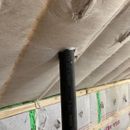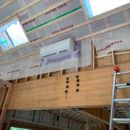Condensation concerns with pipe penetrations
I have a few places where I have pipes that penetrate my thermal envelope and I want to determine if I have any possible condensation issues.
1) My plumbing vent pipes (ABS) penetrate my insulated gable roof that stacks up as follows: 5/8 sheetrock (detailed to act as an air barrier), Insulweb netting, 9.25″ DP cellulose, Zip sheathing, 4″ polyiso, air gap, cedar shingles. The pipe penetrations are spray foamed and taped on the exterior.
2) I have a metal hose bibb that penetrates an exterior wall that stacks up similar to the roof, except it is a 2×6 cavity and the exterior insulation is 3″ of Roxul. The Siga Majrex acts as the interior air barrier and vapor control layer (note: I will fix the taped penetration in the Majrex that my plumber destroyed and I still have to patch the holes where the cellulose was blown through).
3) I have a PVC condensation pipe that travels from a wall mount unit to a sink location on the interior (you can see it above the ladder). Same stack up as the hose bibb and the penetration is air sealed where it enters the interior space.
4) Supply and exhaust pipes for my ERV penetrate my wall. Same stack up as the hose bibb. They are air tight on both the exterior and interior and the pipe in the conditioned space will have foil faced insulation.
Does anyone see any possible condensation issues in the locations described above?
Thanks,
Jonathan
GBA Detail Library
A collection of one thousand construction details organized by climate and house part














Replies
There is probably minimal risk. If you’re worried, some pipe wrap insulation, just the regular stuff the is R3 if I’m remembering correctly, should give you added protection.
A simple trap will stop any air leaks. You shouldn’t have enough pressure differential between inside and outside of your building envelope to blow the water out of the trap.
Bill
Thanks Bill. Ironically, my R3 polyethylene pipe insulation for my hot water lines showed up yesterday and the 3/4" fits perfectly around the hose bibb.
Be careful insulating a hose bib penetration on the indoor side if it's not a freeze-proof type. Insulation works both ways, and sometimes you need some heat leaking into those pipes to keep them from freezing.
Bill
> a metal hose bibb that penetrates an exterior wall
It will have some condensation risk and if you don't leave enough exposed cold metal on the interior, it can freeze at the valve (even the "frost proof" type). A guess - double the exposed metal area on the inside vs the wind exposed outside (which your picture doesn't appear to have). Of course if you turn off the water and drain the line, there is no freeze risk (so you could insulate all of the exposed metal). Or add heat tape.
In zone 4A NJ the freeze up risk is pretty limited, especially if the hose bib is covered with a purpose-made molded EPS box in sub-freezing weather. That would also reduce wintertime risk of condensation on uninsulated pipe.
In summer cold water pipes can sweat condensation in that climate if the indoor humidity isn't controlled.
BTW: The ductless head looks like it might violate some manufacturers' specs for clearance to the top once the ceiling gypsum goes up. Hopefully that was triple-checked(?).